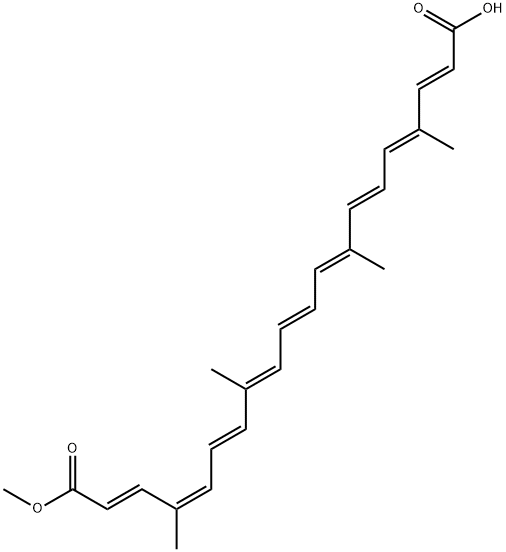B-CRYPTOXANTHIN
Synonym(s):Caricaxanthin;Hydroxy-β-carotene
- CAS NO.:472-70-8
- Empirical Formula: C40H56O
- Molecular Weight: 552.87
- MDL number: MFCD09763658
- EINECS: 200-001-8
- SAFETY DATA SHEET (SDS)
- Update Date: 2024-08-01 17:24:36

What is B-CRYPTOXANTHIN?
Description
Cryptoxanthin?is one of a class of carotenoids called xanthophylls. Its structure is identical to that of β-carotene except that it has a hydroxyl group. Like carotene, it is converted to vitamin A in the human body and acts as an antioxidant. Xanthophylls (from Greek xanthos, yellow) are found in leaves and flowers; when the chlorophyll in leaves is denatured by cold weather, xanthophylls are responsible for leaves’ changing to yellow and red colors.
Chemical properties
Garnet-red prisms with metallic luster. Soluble in chloroform, benzene, and pyridine; slightly soluble in alcohol and methanol.
The Uses of B-CRYPTOXANTHIN
A natural caratenoid pigment that is converted to Vitamin A in the human body. It is an antioxidant and may help prevent free radical damage to cells and DNA, as well as stimulate the repair of oxidative damage to DNA. A potential chemopreventative agent against lung cancer as well as other types of cancer.
The Uses of B-CRYPTOXANTHIN
β-Cryptoxanthin has also been used to study its effect on the production of immunoglobulins in Peyer′s patch cells ex- vivo. It has also been used as a standard in high-performance liquid chromatography (HPLC analysis).(5)
What are the applications of Application
β-Cryptoxanthin is a carotenoid pigment showing antioxidant activity
Definition
ChEBI: A carotenol that exhibits antioxidant activity. It has been isolated from fruits such as papaya and oranges.
General Description
β-Cryptoxanthin is an oxygen-containing carotenoid and is a member of the xanthophyll family. It is one of the major sources of vitamin A and is present in fruits such as oranges, tangerines and papayas. In addition, it is also found in corn, peas and some animal products such as egg yolk and butter.
Biochem/physiol Actions
β-Cryptoxanthin exhibits?potential-anabolic effect on bone calcification?by stimulating osteoblastic bone formation and inhibiting osteoclastic bone resorption in vitro. It acts as an antioxidant and avoids free radical damage to biomolecules such as lipids, proteins and nucleic acids. High dietary intake of β-cryptoxanthin reduces the risk of developing rheumatoid arthritis and lung cancer.
Purification Methods
Purify it by chromatography on MgO, CaCO3 or deactivated alumina, using EtOH or diethyl ether to develop the column. Crystallise it from *C6H6/EtOH (metallic prisms), or needles from *C6H6. Store it in the dark under N2 or Ar at -20o. The acetate has m 117.5o. The racemate is purified through a column of alumina (grade IV), eluted with *C6H6 then EtOAc/*C6H6 (1:9) and recrystallised from pet ether (b 60-80o) with m 172-173o. [Loeber et al. J Chem Soc (C) 404 1971, Goodfellow et al. J Chem Soc Chem Commun 1578 1970, Isler et al. Helv Chim Acta 40 456 1957, Beilstein 6 III 3772, 6 IV 5111.]
Properties of B-CRYPTOXANTHIN
| Melting point: | 167℃ |
| Boiling point: | 563.32°C (rough estimate) |
| Density | 0.974±0.06 g/cm3 (20 ºC 760 Torr) |
| refractive index | 1.4800 (estimate) |
| storage temp. | -20°C |
| solubility | chloroform: soluble1mg/mL |
| pka | 14.90±0.70(Predicted) |
| form | Solid |
| color | Red to dark red |
Safety information for B-CRYPTOXANTHIN
| Signal word | Warning |
| Pictogram(s) |
 Exclamation Mark Irritant GHS07 |
| GHS Hazard Statements |
H315:Skin corrosion/irritation H319:Serious eye damage/eye irritation H335:Specific target organ toxicity, single exposure;Respiratory tract irritation |
| Precautionary Statement Codes |
P261:Avoid breathing dust/fume/gas/mist/vapours/spray. P305+P351+P338:IF IN EYES: Rinse cautiously with water for several minutes. Remove contact lenses, if present and easy to do. Continuerinsing. |
Computed Descriptors for B-CRYPTOXANTHIN
New Products
Tert-butyl bis(2-chloroethyl)carbamate (S)-3-Aminobutanenitrile hydrochloride N-Boc-D-alaninol N-BOC-D/L-ALANINOL 3-(2,4-Dimethoxybenzyl)dihydropyrimidine-2,4(1H,3H)-dione 7-Bromo-1H-indazole N-octanoyl benzotriazole 3,4-Dibenzyloxybenzaldehyde 4-Hydrazinobenzoic acid Electrolytic Iron Powder Fmoc-Val-Cit-PAB 1,1’-CARBONYLDIIMIDAZOLE R-2-BENZYLOXY PROPIONIC ACID 4-HYDROXY BENZYL ALCOHOL 1,1’-CARBONYLDI (1,2-4 TRIAZOLE) S-2-CHLORO PROPIONIC ACID (2-Hydroxyphenyl)acetonitrile 4-Bromopyrazole 5-BROMO-2CYANO PYRIDINE 5,6-Dimethoxyindanone 5-broMo-2-chloro-N-cyclopentylpyriMidin-4-aMine 1-(4-Methylphenylsulfonyl)-1H-1,2,3-benzotriazole 1-(2-Chlorobenzyl)-4-nitro-1H-pyrazole 1-(2-Nitrophenyl)-4-phenylpiperazineRelated products of tetrahydrofuran








You may like
-
 β-Cryptoxanthin CAS 472-70-8View Details
β-Cryptoxanthin CAS 472-70-8View Details
472-70-8 -
 55441-95-7 2 2-BIS(2-HYDROXYETHOXY)-1 1-BINAPHTHYL 99%View Details
55441-95-7 2 2-BIS(2-HYDROXYETHOXY)-1 1-BINAPHTHYL 99%View Details
55441-95-7 -
 Ste-Glu-AEEA-AEEA-OSUView Details
Ste-Glu-AEEA-AEEA-OSUView Details
1169630-40-3 -
 1446013-08-6 Fmoc-His-Aib-OH TFA 98%View Details
1446013-08-6 Fmoc-His-Aib-OH TFA 98%View Details
1446013-08-6 -
 127464-43-1 99%View Details
127464-43-1 99%View Details
127464-43-1 -
 Chloro Uracil 99%View Details
Chloro Uracil 99%View Details
1820-81-1 -
 2-ETHYLPYRIDINE 100-71-0 99%View Details
2-ETHYLPYRIDINE 100-71-0 99%View Details
100-71-0 -
 13162-05-5 99%View Details
13162-05-5 99%View Details
13162-05-5